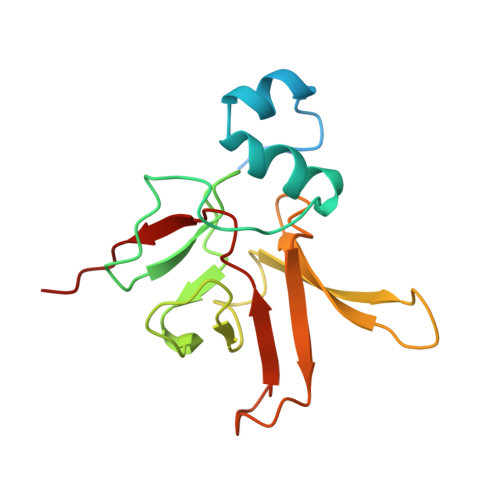Methionine sulfoxide reductase B fromCorynebacterium diphtheriaecatalyzes sulfoxide reduction via an intramolecular disulfide cascade.
Tossounian, M.A., Khanh Truong, A.C., Buts, L., Wahni, K., Mourenza, A., Leermakers, M., Vertommen, D., Mateos, L.M., Volkov, A.N., Messens, J.(2020) J Biol Chem 295: 3664-3677
- PubMed: 31992594
- DOI: https://doi.org/10.1074/jbc.RA119.012438
- Primary Citation of Related Structures:
6TR8 - PubMed Abstract:
Corynebacterium diphtheriae is a human pathogen that causes diphtheria. In response to immune system-induced oxidative stress, C. diphtheriae expresses antioxidant enzymes, among which are methionine sulfoxide reductase (Msr) enzymes, which are critical for bacterial survival in the face of oxidative stress. Although some aspects of the catalytic mechanism of the Msr enzymes have been reported, several details still await full elucidation. Here, we solved the solution structure of C. diphtheriae MsrB (Cd-MsrB) and unraveled its catalytic and oxidation-protection mechanisms. Cd-MsrB catalyzes methionine sulfoxide reduction involving three redox-active cysteines. Using NMR heteronuclear single-quantum coherence spectra, kinetics, biochemical assays, and MS analyses, we show that the conserved nucleophilic residue Cys-122 is S -sulfenylated after substrate reduction, which is then resolved by a conserved cysteine, Cys-66, or by the nonconserved residue Cys-127. We noted that the overall structural changes during the disulfide cascade expose the Cys-122-Cys-66 disulfide to recycling through thioredoxin. In the presence of hydrogen peroxide, Cd-MsrB formed reversible intra- and intermolecular disulfides without losing its Cys-coordinated Zn 2+ , and only the nonconserved Cys-127 reacted with the low-molecular-weight (LMW) thiol mycothiol, protecting it from overoxidation. In summary, our structure-function analyses reveal critical details of the Cd-MsrB catalytic mechanism, including a major structural rearrangement that primes the Cys-122-Cys-66 disulfide for thioredoxin reduction and a reversible protection against excessive oxidation of the catalytic cysteines in Cd-MsrB through intra- and intermolecular disulfide formation and S -mycothiolation.
Organizational Affiliation:
VIB-VUB Center for Structural Biology, B-1050 Brussels, Belgium; Brussels Center for Redox Biology, B-1050 Brussels, Belgium; Structural Biology Brussels, Vrije Universiteit Brussels, B-1050 Brussels, Belgium.















